How to Plant a New Lawn: A Complete Beginner Guide
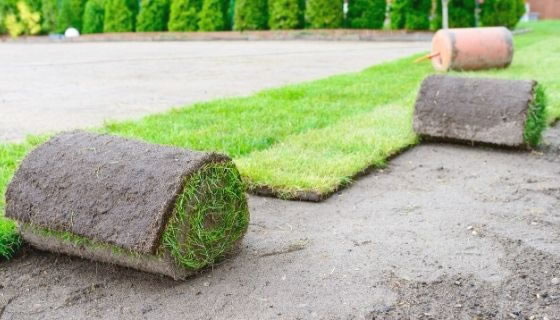
Planting a new lawn is the best way to a subtler look and more excellent value to your yard. It allows you to choose your desired variety of lawn without the hassle. After all, no one wants an imperfect lawn. Well, you don’t need to be a landscaping guru to start a new lawn. If you follow our instructions you will know ‘How to a new lawn in details.
Through the two methods: seeds and sod, you will discover how to grow grass at home. The article may be a mouthful to take in, but you have assured attention to detail and success in gardening. If you experienced any problems before, whether weeds, diseases, or wilting, this is your second chance at making it right.
Step to Take When Starting Off:
Check for weeds
Before preparing your yard for planting, check if any weeds do not infect the area. If you find this right, then apply the correct herbicides on the field. Also, give the herbicides time, maybe a few weeks, to eliminate the weeds before planting your lawn.
Time your planting time right
Be sure to observe whether the time you wish to plant is either recommended or promotes the growth of the lawn—a haphazard approach results in either retarded lawn growth or, worse, plant wilting.
To start a new lawn over an old one.
To plant a new lawn over an old lawn would require you to dig up the old lawn first. And this can be done manually with a shovel or sod cutter or faster mechanically by renting a gas-powered cutter.
Regulate soil pH
You also check the soil’s alkalinity as optimal growth gets achieved with soil pH between 6.0 and 7.5. You can test soil pH yourself using a soil-testing kit you can purchase at a home center or nursery. The manufacturers’ instructions usually require you to mix soil and water in the plastic vial, shake, and observe color changes.

Soil pH
The soil pH then determined by comparing the soil color with the accompanying color-coded chart in the testing kit. For acidic soil, that is below 6.0, and you can raise the required pH by adding crushed lime. The pH for soils above 8.0 lowered using sulfur.
Loosen the soil
Loosen the soil by digging it after marking out the area you wish to plant. Also, remove any sticks or stones you find. Use a garden rake to even the planting area.
Areas new to lawn planting usually consists of ridges and depressions. Ridges get broken down while depressions filled with soil for that flat look. And this is to prevent excess water from flowing to one part of the lawn and not the whole yard.
Apply compost to the soil
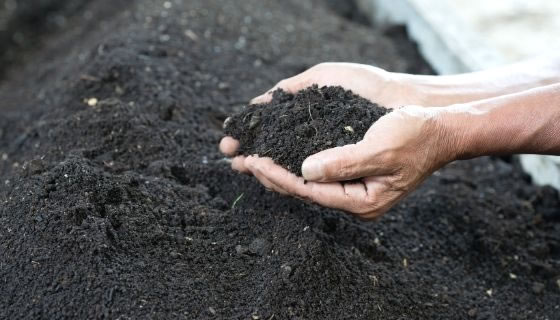
Compost to the soil
You will get assured of optimal growth of lawn, particularly seeded ones, by spreading compost before planting. Compost is mixed with some sand and incorporated into the areas’ soil by tilling, and you improve drainage.
Apply the appropriate fertilizer
Fertilize the soil following the seed and sod requirement. A stern warning: sweep off spilled fertilizer and properly store unused fertilizer out of the children’s reach. Cheap, generic sod and seed brands may save you money now, but they have adverse effects in the long run. Making purchases from local specialist stores saves you the stress if you ever encounter any problem in nurturing the lawn. The term specialist speaks for itself, quick solutions to any mishaps made available if need be.
Take note of the soil slope.
To start a new lawn on your yard, you also need to check your area’s slope. Planting lawn over a steep slope is not recommended as seeds, or young grass may be washed away by rain. Besides this natural occurrence, watering the lawn yourself may prove futile as the water flows downhill. After these preliminaries, I’ll explore the first method of planting from seed.
Method 1: Planting a New Lawn from Seed
Seeding the lawn:
The question of how to seed into your new lawn requires you to follow certain precautions that warrant developments to occur. To ensure the seeds germinate and spring into life, make sure no weed killers used before and after seeding. The weed killers may kill the seeds before their germination or eliminate them as young grass. However, if you had applied such substances to your soil, wait at least three weeks, then start seeding.
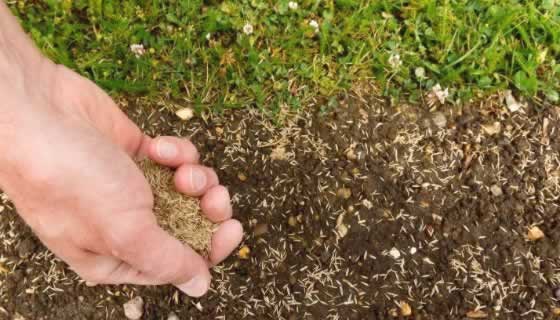
Seeding the lawn
Before spreading seeds, create grooves in the soil. And this promotes soil contact with the seed. Pay attention to the grooves and make them about 5mm from the topsoil. Sunlight penetration, as well as seed sprouting, is stimulated this way. The seed gets mixed with very little soil for easy spreading. Spreading is done by hand for a small yard. On the other hand, a lawn spreader and a drop spreader used for medium and large areas. The drop spreader saves you time in seeding, but if there are budget constraints, you can rent it.
While there is no accurate measure for seed density, apply seeds with spaces between them. Doing otherwise causes retarded growth and weak or thin grasses. An approximation for the application of seeds would be sixteen seeds per square inch. Certain seeds have seed bags printed with the recommended ratio per square meter.
After spreading the seed, topsoil acts as a protective barrier against wind and predators. Use a garden rake to rake not more than 6mm deep for the soil and seeds to mix. Another alternative is mulch, particularly in the summertime, to retain moisture for the seedlings. A significant hindrance to germination that is self-inflicted is stepping on the lawn. Minimize movement along with the lawn till the time you notice the seedlings have fully grown. You can also set a barrier fence to prevent animals from stepping through a newly seeded lawn.
Water the lawn after seeding
The seeds need to be watered immediately after spreading. Then leaving them to dry out decreases their chances of germinating. On the other hand, the seed may rot if overwatered. And to grow grass at home efficiently, there is a need for a water backup supply. The amount of water to apply depends on perceiving weather conditions and grass variety.
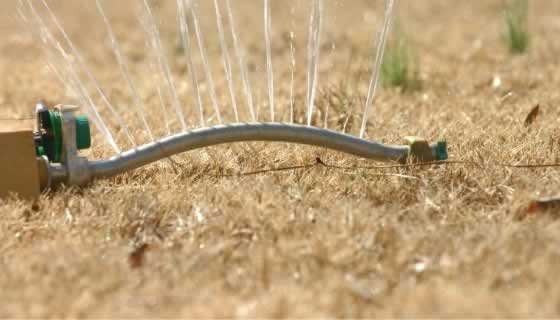
Water the lawn after seeding
Total coverage achieved using sprinklers, but for a small piece of land, you can use a garden hose. During the early stages of seed development, water lightly and do not saturate the lawn area. To grow grass fast and prevent evaporation, water it early in the morning and later in the afternoon.
If you notice the grass is not actively growing, then the lawn does not need as much watering as before. Also, you are not to water the lawn if you notice the ground is frozen. A brown color by the lawn in any period other than the dormant season is a sign of water deficiency.
Consider the ground where you want to plant a new lawn
The issues of when and how to plant grass seeds depend on the acidity and alkalinity of the soil. To foster enhanced plant growth through watering, you have to examine the needs of various soil types. The lawn has less water absorption in sandy soils as they drain fast. For this reason, you have to water the lawn more frequently. Clay soils have slow drainage; thus, you need not water the lawn as much as on sand soils. Lastly, loam soils are a bit of both clay and sand, so observations determine the optimum water requirement.
You can also aerate the soil to improve water penetration. Use a fork to loosen the ground and be careful not to detach lawn roots from the soil. Furthermore, reduce the amount of water you usually sprinkle on the lawn after aeration to keep it moist, not muddy.
Don’t rush to mow your new lawn
Depending on the lawn type, mow the lawn when it reaches between a three and 4-inch height. The best time to do this task is when the soil is dry, as the lawn is less likely to tear. Mowing lawn should get done to less than a third of the grass height at each interval. Starting a new lawn in the spring is a noble initiative indeed but yields slow results. The next method of laying sod provides instant enjoyment guaranteed!
Method 2: Laying Sod to Start New Lawn
Sod is the use of rolls of fresh, green lawn to alter your yard appearance in a few easy steps. Although it is more expensive to set up than the purchase of seeds, sods are, without a doubt, worth every penny. An instant satisfactory look is achieved by simply laying down rolls of the green lawn on your yard. For laying sod, you cannot plant a new lawn over an old lawn as it requires root to soil contact.
Determine sod pieces needed
Once you have determined the soil pH and applied lime or sulfur to regulate it, measurements become performed next. The purpose is to calculate the sod required for the area as well as the cost to acquire it. Since sod dries up quickly, suppliers make it a mandate to provide instant product delivery within 24 hours.
As a customer in the sod business, you buy after making sure the area is ready for the task. Level the land, clear it of debris and moisten it. To ensure the sod stays in condition even before you finish laying, sprinkle some water on it. Note that sod is placed on the edges first for it to start straight.
Laying sod
The edges of sod are the first part that quickly dries up. You may choose to quicken the pace in laying sod, but there’s a risk of the sod tearing or falling apart. Caution must get taken in laying, and raking the soil clears any depressions underneath. Remove air pockets from the ground using a shovel and straighten any folded parts.
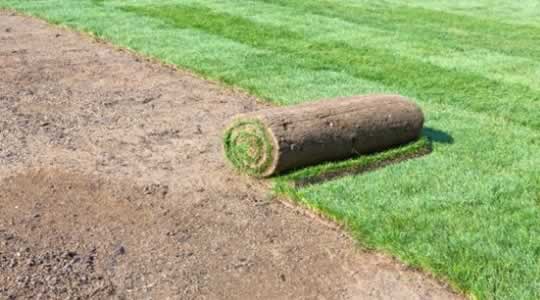
Laying Sod to New lawn
Most yards do not have straight edges throughout, and these gaps should get checked after the lawn becomes entirely laid. These spaces get patched using cut off sod measured as needed for each patch. For much smaller spots such as between sod pieces, simply fill in with more topsoil. Air pockets need to checked for and removed iteratively.
Patting the sod down
The sod needs to become patted down as soon as it gets laid down. Its growth is steady but occurs even it is still rolled out. Interestingly, if it stays longer in a rolled out state, a lot of heat is produced, killing it. If you are dealing with a steep slope, use sod staples to hold the lawn together. Then pat down using a lawn roller, which filled with one-third of the water. And this helps the sod roots set into the soil as well as even the sod pieces.
If you do not own a lawn roller, you can strike down the sod using your feet. Keep your feet close together and step on the sod, especially the edges, and the work is done. And this is usually ideal for those owning small sized lawns, and you need not hire a lawn roller in this case.
Watering the sod
The sod grows best in moist water and not dry or muddy ones. Watering gets done beginning from the point at which the sod was laid down in the ground. Some would prefer to apply water on the part of the area with sod while laying down the remaining portion.
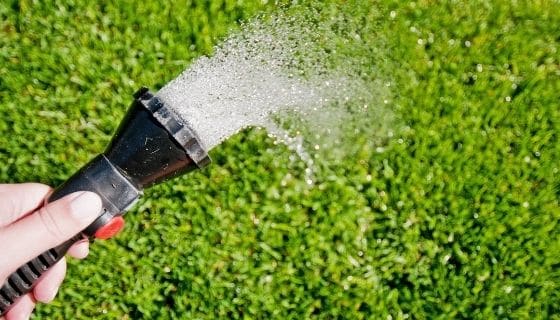
Water the lawn
Gently lift at the corners of the sod, and a sign of progress is the roots on the underside. At this point, you also check whether you are deep watering by examining soil texture by hand. A dry feel is a sign of too little water, while a muddy appearance means otherwise.
Over time, the sod will start resisting the gentle lift routine. And this shows that you are to switch from watering every day to twice or thrice a week deeply. Deep watering is between six to eight inches. You are encouraged to follow the watering routines in seeding to prevent evaporation.
Also, do not sprinkle during the late-night hours as you increase the risk of fungal disease on the plant. The grass grows to approximately 7.5cm to 10cm before having its first mowing session. Always remember to mow down the lawn to less than a third of its height. Also, add nutrients to the soil through the application of fertilizers.
Frequently Asked Questions
1) What month is best to put grass seed down?
It depends on grass seed you want to grow. For the warm season grasses, such as Bahia grass, centipede grass, carpet grass, the best period would be in late spring. Late spring usually characterized by optimal mild temperatures, which promote grass growth.
On the other hand, cool-season grasses such as Kentucky bluegrass, ryegrass flourish between late summer and early spring. To start a new lawn in the spring is, to a certain extent, satisfactory. The slight upset is that young grass has less time to grow before the hot weather.
2) Will grass seed grow if I just throw it down?
Yes, although you have to consider that not all seeds would sprout in these conditions. Furthermore, the long run consists of a diminished germination rate as well as a waste of valuable resources and time. While grass is termed resistant, think of the dreadful look when some of your lawn does not grow.
3)How long does new grass take to grow?
Germination of newly planted grass takes a time of up to three weeks. Keep in mind that this time is average and varies depending on how well you take care of your lawn.
4) I wanted to grow grass fast, so l overseeded. What do l do now?
The best way forward is to let the grass grow, give it time. In the fight for space and nutrients, some seeds will grow, and some will not. In the meantime, apply plenty of water on the grass.
Final Thought
Although sod is more expensive, it has a lot of underlying advantages. Its limitations only based on time, and there is no restriction on the slope profile or when it grows best. To seed, a new lawn, considerable effort, and pilot investigations should put into making the project a success. Whether you have a few bucks to spend or are on a tight fund, home beauty has no limits!
We asserted thoroughly tips and guidelines’ how to plant a new lawn and make your lawn-yard neat-tidy. This is all about our researched based guidelines to make lawn beauty and plant your lawn with the easy way. We think it will be helpful to do so.

Trackbacks/Pingbacks